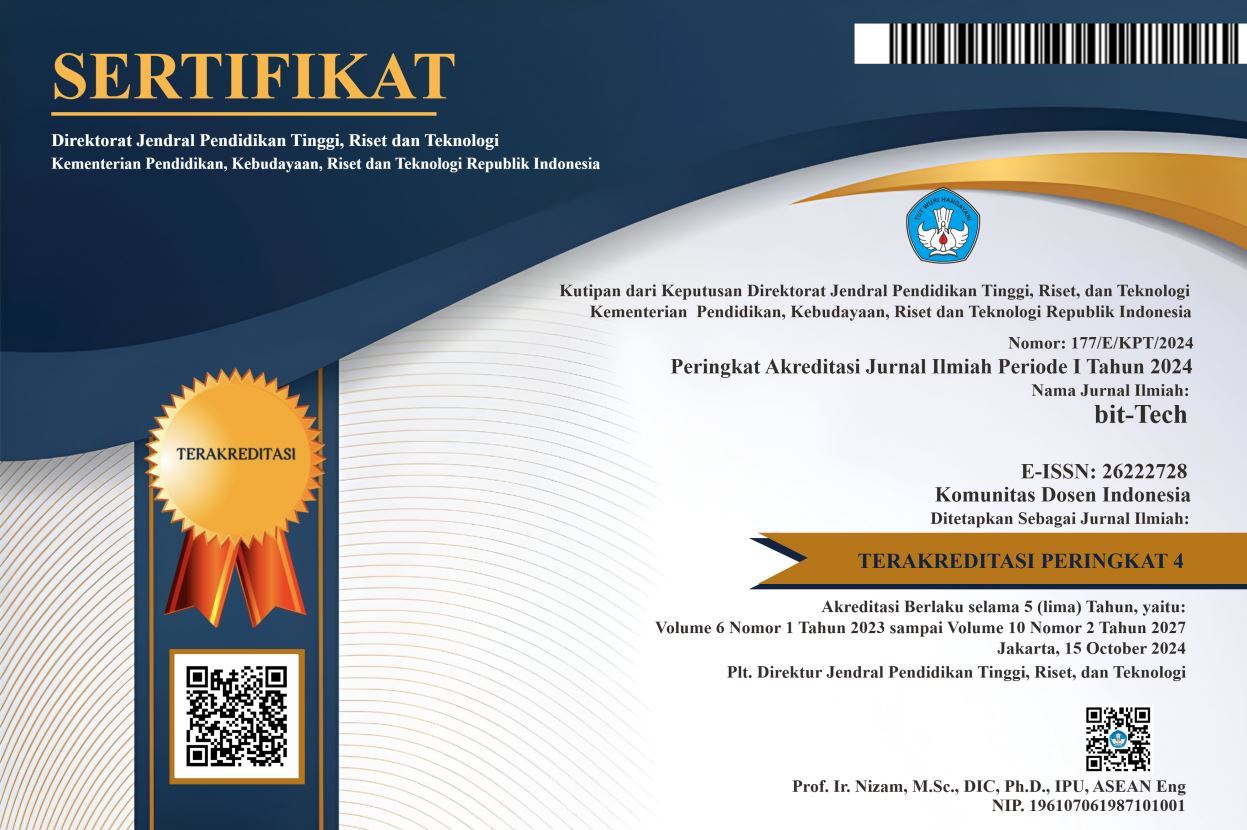Network Attack Detection Using Intrusion Detection System Utilizing Snort Based on Telegram
DOI:
https://doi.org/10.32877/bt.v6i2.943
Keywords:
Cybercrimes, Intrusion Detection System , Network Attack Detector, Snort , Telegram
Abstract
The constantly evolving of information technology landscape has made information security something of paramount importance, yet the development of information technology is not met with a corresponding advancement in its security systems. As a result, in the current era, there is a multitude of cybercrimes in the realm of the internet. Therefore, this research aims to create a computer network attack detector using the Linux operating system by leveraging the Telegram-based Snort application and employing the Intrusion Detection System (IDS) method through an IDS-based application, namely Snort. Additionally, this study incorporates features for blocking IP addresses and changing the Linux server password through the Telegram application for initial response when an attack is detected, accomplished by sending specific commands within the Telegram application. Furthermore, this paper also introduce a feature for categorizing the risk of computer network attacks into three categories: Low, Medium, and High within the Telegram application. The results of this research demonstrate that Snort can detect predefined rules and send alerts to the Telegram application for every attack occurring within the Wireless Local Area Network (WLAN). Successful IP address blocking is achieved through Telegram integration with the Iptables application, and changing the Linux server password is also accomplished through Telegram by integrating the bash shell programming language found in the Terminal of the Linux operating system. Finally, the risk of attacks can be viewed within the Telegram application.
Downloads
References
R. Pangestu and A. Solichin, “Klasifikasi Serangan Jaringan Menggunakan Metode Decision Tree Berbasis Website,” Jurnal Seminar Nasional Mahasiswa Fakultas Teknologi Informasi (SENAFTI), vol. 1, no. 1, pp. 614–620, Apr. 2022, [Online]. Available: https://senafti.budiluhur.ac.id/index.php/
B. Wijaya and A. Pratama, “Deteksi Penyusupan Pada Server Menggunakan Metode Intrusion Detection System (IDS) Berbasis Snort,” SISFOKOM(Sistem Informasi dan Komputer), vol. 09, no. 1, pp. 97–101, 2020, doi: 10.32736/sisfokom.v9.i1.770.
L. F. Nainggolan, N. F. Saragih, and F. G. N. Larosa, “Monitoring Keamanan Jaringan Pada Server Ubuntu Dari Serangan DDoS Menggunakan Snort IDS,” Jurnal Ilmiah Teknik Informatika , vol. 2, no. 2, pp. 1–10, Apr. 2022, [Online]. Available: http://ojs.fikom-methodist.net/index.php/METHOTIKA
I. G. W. Bangga and S. M. Ladjamuddin, “SIMULASI SNORT SEBAGAI ALAT PENDETEKSI INTRUSI PADA WEB DAMN VULNERABLE WEB APPLICATION,” Jurnal Rekayasa Informasi, vol. 11, no. 2, pp. 160–167, Apr. 2022.
P. S. Fat, Khairil, and E. P. Rohmawan, “Perancangan Dan Implementasi Intrusion Detection System (IDS) Untuk keamanan Wireless Local Area Network (WLAN) Pada SMKN 5 Kota Bengkulu,” Jurnal Media Computer Science, vol. 2, no. 1, pp. 1–8, 2023.
B. Pasaribu and W. Susanti, “Sistem Informasi Pengajuan Rancangan Usulan Penelitian Menggunakan PHP Native dan Bot Telegram,” Jurnal Mahasiswa Aplikasi Teknologi Komputer dan Informasi, vol. 3, no. 1, pp. 29–38, 2021, [Online]. Available: http://www.php.net.
A. Fathurrozi and F. Karimah, “Pelayanan Dan Informasi Customer Service Berbasis Bot Telegram Dengan Algoritma Forward Chaining Pada CV.Primguard Indonesia,” Journal of Information and Information Security (JIFORTY), vol. 2, no. 2, pp. 211–226, 2021, [Online]. Available: http://ejurnal.ubharajaya.ac.id/index.php/jiforty
Murtopo, Khairil, and Gunawan, “Perancangan Media Pembelajaran Agama Islam Secara Interaktif Berbasis Aplikasi Telegram Bot pada Politeknik Negeri Media Kreatif,” ANALYTICA ISLAMICA, vol. 11, no. 2, pp. 311–326, Jun. 2022, [Online]. Available: https://balitbangsdm.kominfo.go.id
R. Suwanto, I. Ruslianto, and M. Diponegoro, “IMPLEMENTASI INTRUSION PREVENTION SYSTEM(IPS) MENGGUNAKAN SNORT DAN IPTABLE PADA MONITORING JARINGAN LOKAL BERBASIS WEBSITE,” Jurnal Komputer dan Aplikasi, vol. 7, no. 1, pp. 97–107, 2019.
Desmira, “SISTEM KEAMANAN OPERASI LINUX UBUNTU IPTABLES SEBAGAI FIREWALL DI DINAS PENDIDIKAN KABUPATEN SERANG,” Jurnal Khatulistiwa Informatika, vol. 9, no. 1, pp. 17–22, 2021.
Nurhanif and Z. Maizi, “PEMBUATAN PETA JARINGAN UNTUK MEMONITORING KONEKSI KOMPUTER MENGGUNAKAN PEMROGRAMAN BASH SCRIPT,” Journal of Informatics and Computer Science, vol. 5, no. 2, pp. 164–173, Jun. 2019.
Runimeirati, A. Muis, and F. Muhammad, “Pelatihan Text Mining Menggunakan Bahasa Pemrograman Python,” Jurnal Pengabdian Kepada Masyarakat, vol. 3, no. 1, pp. 37–46, 2023, [Online]. Available: https://pusdig.web.id/index.php/abdimas/index
F. Caccavale, C. L. Gargalo, K. V. Gernaey, and U. Krühne, “SPyCE: A structured and tailored series of Python courses for (bio)chemical engineers,” Education for Chemical Engineers, vol. 45, pp. 90–103, Oct. 2023, doi: 10.1016/j.ece.2023.08.003.
M. I. Rafi and Saudi, “Rancang Bangun Jaringan FTP Server dengan Menggunakan Windows Server,” NetPLG Journal of Network and Computer Applications, vol. 1, no. 2, pp. 34–49, 2022, [Online]. Available: https://jurnal.netplg.com/jnca
Desmira and R. Wiryadinata, “Rancang Bangun Keamanan Port Secure Shell (SSH) Menggunakan Metode Port Knocking,” JIKOMSI [Jurnal Ilmu Komputer dan Sistem Informasi, vol. 5, no. 1, pp. 28–33, 2022.
T. Shi, J. Fu, and X. Hu, “TSE-Tran: Prediction Method of Telecommunication-network Fraud Crime Based on Time Series Representation and Transformer,” Journal of Safety Science and Resilience, vol. 4, pp. 340–347, Dec. 2023, doi: 10.1016/j.jnlssr.2023.07.001.
R. Hermawan, “TEKNIK UJI PENETRASI WEB SERVER MENGGUNAKAN SQL INJECTION DENGAN SQLMAP DI KALILINUX,” STRING (Satuan Tulisan Riset dan Inovasi Teknologi), vol. 6, no. 2, pp. 210–216, 2021.
Q. Abu Al-Haija, “Cost-effective detection system of cross-site scripting attacks using hybrid learning approach,” Results in Engineering, vol. 19, Sep. 2023, doi: 10.1016/j.rineng.2023.101266.
Downloads
Published
How to Cite
Issue
Section
License
Copyright (c) 2023 bit-Tech : Binary Digital - Technology

This work is licensed under a Creative Commons Attribution-ShareAlike 4.0 International License.
I hereby assign and transfer to bit-Tech all exclusive copyright ownership rights to the above work. This includes, but is not limited to, the right to publish, republish, downgrade, distribute, transmit, sell, or use the work and other related materials worldwide, in whole, or in part, in all languages, in electronic, printed, or any other form of media, now known or hereafter developed and reserves the right to permit or license a third party to do any of the above. I understand that this exclusive right will belong to bit-Tech from the date the article is accepted for publication. I also understand that bit-Tech, as the copyright owner, has sole authority to license and permit reproduction of the article. I understand that, except for copyright, any other proprietary rights associated with the work (e.g. patents or other rights to any process or procedure) must be retained by the author. In addition, I understand that bit-Tech permits authors to use their papers in any way permitted by the applied Creative Commons license.


 DOI :
DOI :
 Abstract views: 244
/
Abstract views: 244
/  PDF downloads: 246
PDF downloads: 246











